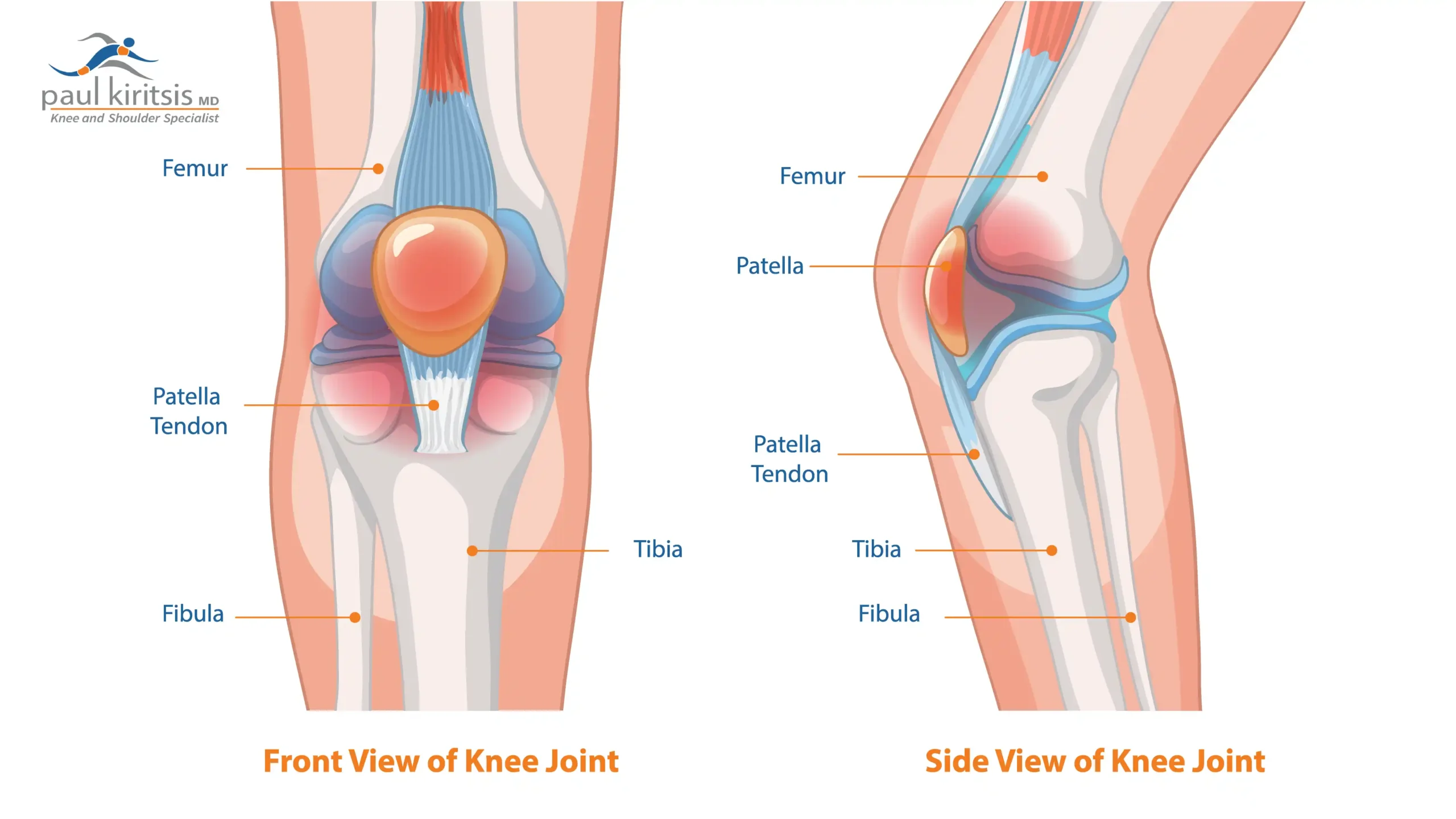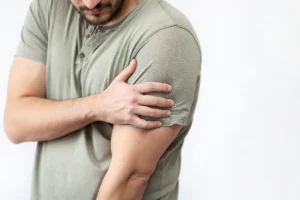If you experience knee pain and are wondering whether you have Jumpers Knee vs Runners Knee, it’s helpful to know the differences. Jumpers Knee, or patellar tendinitis, is pain below the kneecap, while Runners Knee, known as patellofemoral pain syndrome, involves pain around or behind the kneecap. This post explores the symptoms, causes, and treatments for both conditions.
Key Takeaways
- Runner’s knee and jumper’s knee are distinct overuse injuries characterized by different pain locations and underlying causes, requiring tailored treatment approaches.
- Symptoms of runner’s knee include aching pain around the patella, while jumper’s knee presents with pain below the kneecap; understanding these nuances aids accurate diagnosis.
- Preventative measures such as proper training techniques, dynamic stretching, and maintaining a healthy weight are crucial in reducing the risk of both knee injuries.
Understanding Runner’s Knee and Jumper’s Knee
Runner’s knee, known in the medical world as patellofemoral pain syndrome (PFPS), is a prevalent condition that manifests as pain around or behind the kneecap due to abnormal patellar movements. This type of knee pain is often experiencing knee pain by those who engage in activities that involve extensive knee bending, such as running, squatting, or climbing stairs.

On the other hand, jumper’s knee, or patellar tendinitis, is characterized by pain below the knee cap, where the patellar tendon connects the kneecap to the patella. This condition is typically associated with repetitive stress on the patellar tendon from jumping activities.

Both conditions are overuse injuries but affect different structures and present distinct symptoms. Runner’s knee results from abnormal contact and movement patterns of the patella on the femur, often due to muscle imbalances or poor biomechanics. In contrast, jumper’s knee is primarily caused by repetitive stress and strain on the patellar tendon from activities like jumping or running, leading to inflammation and pain. The comparison of runner’s knee vs jumper’s knee highlights these differences.
Young and active individuals, especially athletes, are the most susceptible to these conditions. Whether you’re dealing with runner’s knee or jumper’s knee, understanding these key differences is the first step toward effective treatment and prevention. Recognizing the specific structures involved and the activities that exacerbate each condition can help tailor a more precise and effective approach to managing knee pain.
Symptoms and Pain Characteristics
The symptoms of runner’s knee and jumper’s knee can often be confused, but they have distinct pain characteristics that set them apart. Runner’s knee typically presents as aching pain around or behind the kneecap, which can worsen with movement or prolonged sitting. This condition may also cause a grinding sensation inside the knee, along with swelling and a reduced range of motion. Activities that involve bending the knee, such as climbing stairs or squatting, can significantly aggravate the pain.
In contrast, jumper’s knee is marked by discomfort below the kneecap, where the patellar tendon attaches to the patella. This pain usually develops gradually and worsens with repetitive jumping activities. Over time, the pain can intensify, especially during high-impact activities like jumping or kneeling. The symptoms of jumper’s knee can also include localized tenderness and swelling around the patellar tendon.
These differing pain characteristics are important for proper diagnosis and treatment. While runner’s knee pain often revolves around the patella’s movement, jumper’s knee pain focuses on the patellar tendon’s response to repetitive stress. Understanding these nuances can help in describing the pain accurately to a healthcare provider, leading to better-targeted treatments and quicker pain relief.
Causes and Risk Factors
The primary cause of both runner’s knee and jumper’s knee is overuse. This means that engaging in repetitive activities without adequate rest or recovery can lead to these conditions. However, the specific risk factors and causes can vary. For example, training errors, such as a sudden increase in intensity or volume of physical activity, are common culprits for developing runner’s knee. Different knee structures can also lead to varied pain patterns, contributing to the development of either condition.
Understanding these underlying factors allows individuals to take proactive steps to mitigate the risk of knee injuries. Recognizing the importance of proper training techniques, adequate rest, and addressing muscle imbalances can go a long way in preventing both runner’s knee and jumper’s knee.
Causes of Runner’s Knee
Runner’s knee is primarily caused by overuse, improper form, and muscular imbalances. When there is a sudden increase in the frequency, intensity, or type of physical activity, it can lead to excessive pressure on the femur, resulting in runners knee. Muscle imbalances around the knee and hip can exacerbate this condition, making it more difficult for the patella to move smoothly within the femoral groove.
Athletes and active individuals are particularly susceptible to developing these abnormal movement patterns that lead to runner’s knee. Ensuring proper form during physical activities and addressing any muscle weaknesses can help in preventing this overuse injury.
Causes of Jumper’s Knee
Jumper’s knee is primarily caused by repetitive stress on the patellar tendon from jumping activities. Sports that involve frequent jumping, running, or other high-impact activities can exacerbate this condition. As a result of this repetitive stress, the patellar tendon experiences inflammation and irritation, leading to pain and discomfort.
Athletes should be mindful of the intensity and frequency of their jumping activities and ensure proper technique to minimize stress on the tendon.
Diagnosis Methods for Knee Injuries
Diagnosing knee injuries like runner’s knee and jumper’s knee requires a thorough medical history and physical examination. Consulting with an orthopedic surgeon to determine the underlying cause of knee pain and receive a proper diagnosis is essential. A detailed physical examination and review of the patient’s medical history can help differentiate jumper’s knee from other knee conditions.
Imaging tests are commonly utilized to assess knee injuries. X-rays can identify fractures and joint diseases, while MRI scans are particularly useful for examining ligaments, tendons, and cartilage damage. The vast majority of patients being treated for these issues will not require advanced imaging.
These diagnostic methods are helpful in developing an effective treatment plan. Accurately identifying the nature of the knee injury enables healthcare providers to recommend the most appropriate interventions to alleviate pain and promote healing.
Treatment Options for Runner’s Knee and Jumper’s Knee
Treatment options for runner’s knee and jumper’s knee typically start with conservative approaches. Surgery is not required for these conditions, with the overwhelming majority of cases responding well to non-surgical treatments. The RICE method, which stands for Rest, Ice, Compression, and Elevation, is a fundamental strategy for managing knee injuries. This approach helps reduce inflammation, alleviate pain, and promote healing.
Additional supportive measures include taping and strapping techniques, which can support the knee joint, relieve pressure on the patella, and prevent further damage. For those experiencing pain from jumper’s knee, rest and consultation with a joint specialist for personalized treatment recommendations are crucial.
Conservative Treatments
Conservative treatments for knee injuries include the POLICE principle: Protection, Optimal Loading, Ice, Compression, and Elevation. This strategy is effective for managing knee pain and promoting recovery. Non-Steroidal Anti-Inflammatory Drugs (NSAIDs) are commonly used to reduce pain and inflammation associated with knee injuries.
Cold therapy is recommended for overuse injuries, as it helps reduce inflammation and relieve pain. Physical therapy plays an important role in restoring strength and flexibility for both runner’s knee and jumper’s knee.
Using a knee brace can offer additional support during recovery from runner’s knee.
Advanced Treatment Options
For jumpers need, PRP injections have been shown to significantly improve symptoms and promote healing of the damage tendon. In severe cases where conservative treatments are not effective, surgical intervention may be considered. Surgical options for runner’s knee and jumper’s are rarely indicated. For jumpers knee, and arthroscopic debridement of the damaged patellar tendon can often be helpful. Surgical options for runners knee are rarely an option.
Prompt and appropriate treatment is crucial to prevent jumper’s knee from becoming chronic, which can result in persistent pain and dysfunction. By addressing severe cases early, individuals can achieve better outcomes and return to their activities with minimal disruption.
Preventing Knee Pain and Injuries
A proactive approach is necessary to prevent knee pain. This can help avoid injuries as well. Runner’s knee constitutes 20 to 40 percent of all knee-related issues, making it a significant concern for athletes and active individuals. Jumper’s knee can vary greatly in prevalence among athletes, ranging from 0% to 45% based on the sport. Training errors, such as inappropriate increases in workout intensity or duration, contribute to the risk of developing runner’s knee.
Wearing supportive footwear helps in aligning the legs properly and reducing knee pain. Maintaining a healthy weight supports knee health and reduces strain on joints. By implementing these preventive measures, individuals can significantly reduce their risk of knee injuries and maintain an active lifestyle.
Prevention Tips for Runner’s Knee
Strengthening the quadriceps and hamstrings is vital for alleviating stress on the patellar tendon and preventing runner’s knee. Regularly incorporating cross-training can help prevent overuse injuries by diversifying the types of physical activities performed. Flexibility exercises can also alleviate pressure on the knees, enhancing overall knee health.
Improper warm-up routines can increase susceptibility to runner’s knee, making it essential to perform adequate warm-up exercises before engaging in high-impact activities. Using appropriate footwear with adequate support can minimize the risk of runner’s knee by ensuring proper alignment and reducing impact on the knees. Proper biomechanics during physical activities are critical to avoid exacerbating knee injuries.
Prevention Tips for Jumper’s Knee
Dynamic stretching before physical activities is effective in preventing jumper’s knee. Incorporating dynamic stretching before workouts can enhance flexibility and reduce the risk of jumper’s knee. Maintaining a healthy body weight can lessen the strain on the knees, helping to prevent injuries.
Combining dynamic stretching with weight management provides a comprehensive approach to preventing jumper’s knee injuries. By adopting these preventive measures, athletes can minimize the risk of developing jumper’s knee and maintain their performance levels.
Rehabilitation and Recovery
Rehabilitation and recovery from knee injuries involve regular exercise and low-impact activities to maintain knee health. Incorporating low-impact exercises like swimming and cycling can help protect the knees while promoting strength and flexibility. The typical recovery time for knee injuries is 6-8 weeks, during which physical therapy can play a crucial role in enhancing recovery outcomes.
Individuals experiencing persistent knee pain should seek physical therapy to address underlying issues and prevent further damage. A structured rehabilitation program can help individuals regain strength and function, allowing for a safe return to their activities.
Rehabilitation Exercises
Strengthening the quadriceps muscles can provide better support for the patellar tendon, aiding in the recovery from knee injuries. Recommended exercises include those using resistance bands, as well as lower-impact options like swimming, isometrics, and straight leg raises. Eccentric strengthening has also been shown to be helpful. It is essential to avoid high-impact exercises like lunging, running, jumping, or stair climbing until inflammation decreases and a full range of motion is achieved.
Before starting strengthening exercises, it is important to wait until the knee has a full range of motion and is free of pain to avoid further damage. Following a structured rehabilitation plan can help individuals recover more effectively and reduce the risk of re-injury.
Monitoring and Adjusting Activity Levels
Monitoring and gradually adjusting activity levels is critical to preventing re-injury after knee pain subsides. After the pain from jumper’s knee subsides, a gradual return to running is recommended. It’s important to implement proper biomechanics changes during this process. By ensuring that the body’s biomechanics are correct, individuals can reduce the strain on their knees and prevent future injuries.
A gradual increase in activity intensity is important to prevent re-injury when returning to sports after knee pain subsides. This approach helps the body adapt to increased demands without overloading the knees. Careful monitoring of activity levels and making necessary adjustments based on pain and performance can help maintain knee health and prevent further injuries.
Summary
In conclusion, understanding the key differences between runner’s knee and jumper’s knee is essential for proper diagnosis and treatment. Runner’s knee, associated with abnormal patellar movements, and jumper’s knee, resulting from repetitive stress on the patellar tendon, affect different structures and present distinct symptoms. Accurate diagnosis through a thorough medical history, physical examination, and imaging tests is crucial for developing an effective treatment plan.
Preventive measures, including proper training techniques, supportive footwear, and maintaining a healthy weight, can significantly reduce the risk of knee injuries. Conservative treatments, such as the RICE method, physical therapy, and the use of supportive products, play a vital role in managing knee pain and promoting recovery. In severe cases, surgical intervention may be necessary to address significant tendon damage.
By taking a proactive approach to prevention and adhering to a structured rehabilitation program, individuals can maintain knee health and enjoy a pain-free, active lifestyle.
Frequently Asked Questions
What is the main difference between runner’s knee and jumper’s knee?
The main difference is that runner’s knee involves pain around the kneecap, while jumper’s knee is characterized by pain below the kneecap due to stress on the patellar tendon. Understanding this distinction can help in targeting appropriate treatments for each condition.
How can I prevent runner’s knee?
To prevent runner’s knee, focus on strengthening your quadriceps and hamstrings, incorporate cross-training, maintain flexibility, wear suitable footwear, and ensure proper biomechanics during activities. These steps can significantly reduce your risk of developing this condition.
What are the conservative treatments for jumper’s knee?
Conservative treatments for jumper’s knee effectively include the POLICE principle (Protection, Optimal Loading, Ice, Compression, Elevation), NSAIDs for pain relief, physical therapy, and supportive devices. These approaches help manage symptoms and promote healing. PRP injections have also been shown to be helpful.
When should I consider surgical intervention for knee pain?
You should consider surgical intervention for knee pain when conservative treatments have failed and you are experiencing severe symptoms, particularly in conditions like runner’s or jumper’s knee. Consulting with a an orthopedic surgeon can help determine if surgery is necessary based on the extent of your injury.
How long does it take to recover from knee injuries?
Recovery from knee injuries usually takes 6-8 weeks, with regular exercise and physical therapy significantly improving outcomes. Engaging in low-impact activities can also assist in regaining strength and function.





